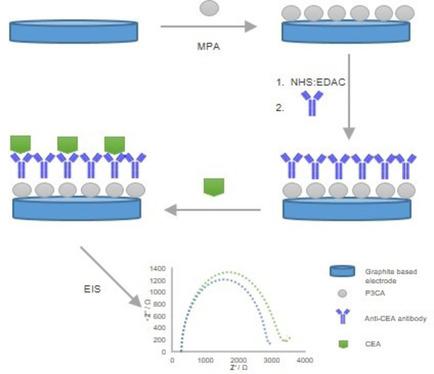当前位置:
X-MOL 学术
›
Electroanalysis
›
论文详情
Our official English website, www.x-mol.net, welcomes your
feedback! (Note: you will need to create a separate account there.)
Poly‐(pyrrole‐3‐carboxylic acid) Based Nanostructured Platform for the Detection of Carcinoembryonic Antigen
Electroanalysis ( IF 2.7 ) Pub Date : 2018-02-19 , DOI: 10.1002/elan.201700803 Andreea Iordănescu 1 , Mihaela Tertis 1 , Andreea Cernat 1 , Maria Suciu 2 , Robert Săndulescu 1 , Cecilia Cristea 1
Electroanalysis ( IF 2.7 ) Pub Date : 2018-02-19 , DOI: 10.1002/elan.201700803 Andreea Iordănescu 1 , Mihaela Tertis 1 , Andreea Cernat 1 , Maria Suciu 2 , Robert Săndulescu 1 , Cecilia Cristea 1
Affiliation

|
A nanostructured platform based on pyrrole 3‐carboxylic acid was developed and it was used for the detection of carcinoembryonic antigen, a biomarker for gastro‐intestinal tract cancers. The conductive polymer offers possibilities for functionalization due to the presence of the carboxylic group. The platform was tailored by polymerizing pyrrole 3‐carboxylic acid at the surface of a graphite‐based screen‐printed electrode by using multiple pulse amperometry and cyclic voltammetry. The carboxylic groups were activated, facilitating the formation of amide covalent bonds with the terminal amine groups from the antibody. Each step's optimization was tracked by performing electrochemical impedance spectroscopy. The immunosensor was successfully applied for the detection of carcinoembryonic antigen in synthetic samples. By comparing pyrrole 3‐carboxylic acid with pyrrole, significantly greater increases of the charge transfer resistance were achieved by using the functionalized monomer for the immobilization step. The binding of the anti‐CEA was reproducible and directly proportional with its concentration. The increase of the charge transfer resistance after the incubation with carcinoembryonic antigen was linearly correlated with the concentration of the sample and the LOD was 33.33 pg mL−1. A simple nanostructured platform for the label‐free detection of a carcinogenic biomarker molecule was developed, thus holding great opportunities for clinical diagnostics and other biosensor applications.
中文翻译:

基于聚(吡咯-3-羧酸)的纳米结构平台,用于检测癌胚抗原。
开发了基于吡咯3-羧酸的纳米结构平台,并将其用于检测癌胚抗原,这是胃肠道癌的生物标记。导电聚合物由于存在羧基而为官能化提供了可能性。该平台是通过使用多脉冲安培法和循环伏安法在基于石墨的丝网印刷电极表面聚合吡咯3-羧酸而定制的。羧基被活化,从而有助于与抗体的末端胺基形成酰胺共价键。通过执行电化学阻抗谱跟踪每个步骤的优化。该免疫传感器已成功应用于合成样品中癌胚抗原的检测。通过将吡咯3-羧酸与吡咯进行比较,通过将官能化单体用于固定步骤,可以显着更大地提高电荷转移阻力。抗CEA的结合是可重现的,并且与其浓度成正比。与癌胚抗原孵育后,电荷转移阻力的增加与样品浓度呈线性相关,LOD为33.33 pg mL-1。开发了一个简单的纳米结构平台,用于无标记的致癌生物标志物分子检测,因此为临床诊断和其他生物传感器应用提供了巨大的机会。
更新日期:2018-02-19
中文翻译:

基于聚(吡咯-3-羧酸)的纳米结构平台,用于检测癌胚抗原。
开发了基于吡咯3-羧酸的纳米结构平台,并将其用于检测癌胚抗原,这是胃肠道癌的生物标记。导电聚合物由于存在羧基而为官能化提供了可能性。该平台是通过使用多脉冲安培法和循环伏安法在基于石墨的丝网印刷电极表面聚合吡咯3-羧酸而定制的。羧基被活化,从而有助于与抗体的末端胺基形成酰胺共价键。通过执行电化学阻抗谱跟踪每个步骤的优化。该免疫传感器已成功应用于合成样品中癌胚抗原的检测。通过将吡咯3-羧酸与吡咯进行比较,通过将官能化单体用于固定步骤,可以显着更大地提高电荷转移阻力。抗CEA的结合是可重现的,并且与其浓度成正比。与癌胚抗原孵育后,电荷转移阻力的增加与样品浓度呈线性相关,LOD为33.33 pg mL-1。开发了一个简单的纳米结构平台,用于无标记的致癌生物标志物分子检测,因此为临床诊断和其他生物传感器应用提供了巨大的机会。









































 京公网安备 11010802027423号
京公网安备 11010802027423号